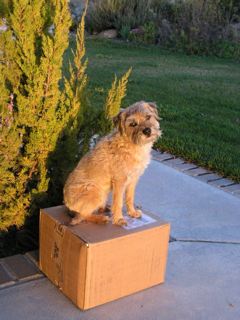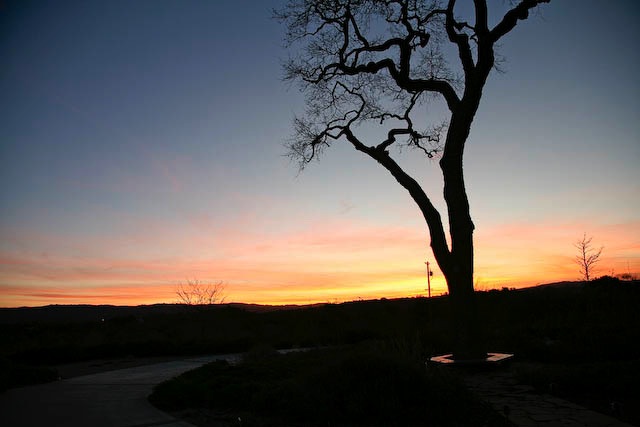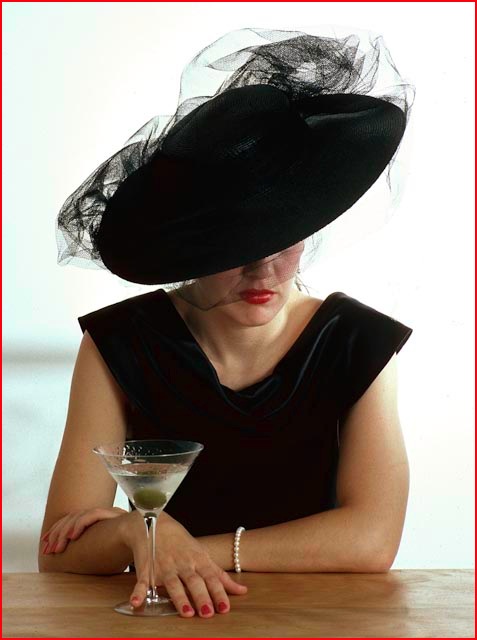First impressions – the Canon EOS 5D in use
Living in central coastal California brings with it many benefits. No big city problems, space to breathe, no pollution and beautiful countryside all around in what is rapidly becoming the Napa Valley of the south.
So it did not take much effort to take the EOS 5D for a short field trip along twisty Santa Rosa Creek Road from Highway 46 all the way down to Cambria.
First, I have to keep reminding myself that this camera was purchased to replace my wonderful medium format gear which, in turn reflected my split thinking about equipment. I love rangefinders, hence the Mamiya 6 three lens outfit (small, fast, quiet). I also like control over variables, thus the Rollei 6003 (big, heavy and noisy). So it’s a tad silly to compare the size and weight of the EOS 5D with the Leica M3, but instructive nonetheless, as both are ‘35mm’ cameras.
With the 24-105mm IS ‘L’ lens the 5D weighs in at just under four pounds, replete with garish strap announcing ‘CANON EOS DIGITAL’ in large woven letters. That will have to go. Not only is it an exercise in poor taste, it cannot be shortened enough to keep the camera at chest height, where it belongs. I have a proper strap on order from Upstrap.com.
The lens hood will be the second thing to go – the worst possible way of advertising ‘photographer’. I’ll check for flare and just let the UV filter take care of protection if flare is not an issue.
Finally, I wish the body was chrome, not black, but that is not an option. The last thing on earth I want to be mistaken for is a professional photographer and black cameras seem to scream ‘pro’. Imagine the three worst things you can say when asked what you do at a party: 1. I work for the IRS. 2. I am a proctologist. 3. I am a professional photographer. Ugh! All guaranteed to clear the room.
A rational 35mm comparison is with the Leica M3, 21mm, 35mm, 50mm and 90mm lenses. That gives a similar focal length range. I don’t have my 35mm as it’s out on loan, so I threw in the Bessa T body where my 21mm usually resides, and the weight comes out to a pound more. Swap the Bessa body for the 35mm and there’s nothing to choose. You trade the convenience of a zoom on the Canon for some of the fastest compact optics made – the 21mm is f/2.8, the others all f/2, compared with the f/4 of the 24-105mm. Now the Canon zoom lens very cleverly gains three stops through the use of the Image Stabilizer technology, but that’s another story.
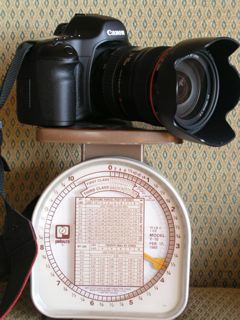
Here’s the film gear on the scale.
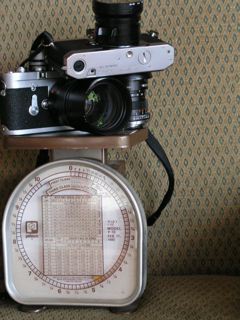
Finally, overall bulk and looks. Ugh! As you can see the Canon is positively gargantuan next to the Leica – like the cuckoo placed parasitically in the poor warbler’s nest by its mother. Even without that ridiculous, poorly designed lens hood, it’s large. As for looks, the body is indistinguishable from any number of competing digital SLRs, meaning it’s largely an amorphous blob which screams ‘designed by computer’. It certainly will not feature in your dreams.
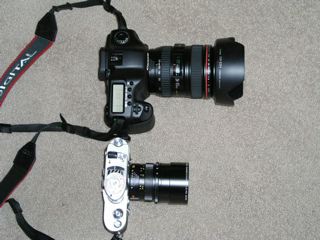
This is not a camera for people with small hands. The controls on the lens are large in diameter and take some getting used to. The zoom ring is not as smooth as one might like, though the manual focus ring is very sweet. The dim viewfinder, compared with the Leica, is remarkably uncluttered, with data readouts below the picture. They are not at all distracting. Indeed, I rather struggled to see these in daylight. What is startling is the speed with which the autofocus works and, at least with my first snaps today, the automatic focusing seems spot on. There is no shutter lag. None. You can take a first pressure on the shutter release to lock focus and exposure and the feel of the release is so well engineered that it could not be improved on. While much softer than the Leica’s, which is surely the gold standard, I would venture to suggest it’s better, as there is less likelihood of camera shake.
I‘m not a serial or bulk shooter so the three frames a second capability is of no use to me, other than it startled me this morning when I didn’t realize I had it on and took three pictures where only one was intended! 3 fps is fast. With no film to wind on, the camera is surprisingly quiet, not as quiet as the Leica, but the noise is largely devoid of metallic overtones, maybe owing to the plastic casing and well damped mirror. That makes it seem quiet. Clever. Well done Canon.
Ask me what the best engineered lenses I have used are and I would unhesitatingly reply Leica and Rollei 6×6, though early all metal Nikon lenses were also excellent when it comes to build quality. No compromises were made in the designs of these lenses as their cost and weight attest. Now this Canon pro-grade lens is a different kettle of fish. It seems very light for its massive bulk when you first pick it up. The general feel of quality is for all to see and, notably, there is absolutely no wobble in the moving parts or barrels, which I have never experienced with a zoom lens before. It doesn’t feel as if it could survive the next nuclear blast, unlike its German counterparts, but time will tell. It focuses to about one quarter life size fully extended. Good to have. The switches for auto/manual focus and for IS on/off on the side of the barrel cannot be moved by accident. At $1,250 it’s a bargain. Have you priced Leica glass recently?
To push things a bit I exposed a couple of shots at one stop down and ISO 200, depending on the noise-free nature of the large sensor to avoid ‘grain’. The 1/250th second exposure computes to 1/2,000 with IS, so camera motion is not an issue. That bears thinking about. Consider how much sharpness is gained from the miracle of reduced image blur which IS confers. 16x enlargements (meaning 16†x 24†from the full frame) were noise free and very sharp in the center. As good as medium format? Too early to say but my first reaction is very positive. I need to take some snaps with lots of fine filigree detail to answer that. If you are one of those photographers who likes resolution charts as purportedly objective measures well, you had better stop reading, because those will never be seen here. My interests in the functioning of camera tools is strictly empirical. Sharpness or resolution are like obscenity. I cannot define them but I know them when I see them.
The peacock’s head, from the center of the frame, is equivalent to a 30x enlargement. Here’s the original:
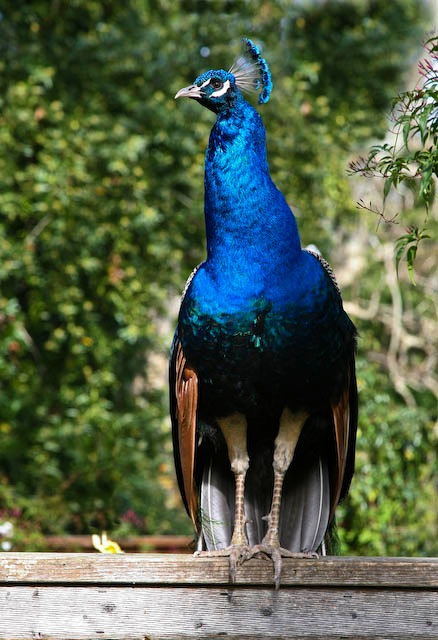
No image sharpening was used other than that provided by the 5D on the Standard setting. Clearly, this lens has potential. You can just see digital artifacts, bearing in mind this is an enormous enlargement. This was at 105mm, ISO 200, one stop down – f/5.6. Autofocus was used. Out of focus highlights are unobtrusive.

Click here and you can see a dozen pictures from this morning’s ramble, including the peacock original. None of these had any post-processing applied and, of course, file sizes were reduced to make loading speed acceptable. Some involve challenging lighting, confirming the exposure meter works well. I used the default Evaluative Metering, making no adjustments to the camera’s choices. These were all taken at the highest quality JPG setting which means files are some 6 megabytes in size, which compares favorably with some 150 megabytes for high quality scans from 120 medium format film. Stated differently, an older G4 Mac will have no problem loading these files in a few seconds. My commiserations is you use Windows.
I have yet to experiment with RAW which evidently yields a file twice the size of highest quality JPG. RAW should allow easy correction of lens barrel distortion and vignetting, so I suppose that’s the way to go.
I made a few 13†x 19†prints on my Epson ink jet after completing the above. Of these, more anon.
